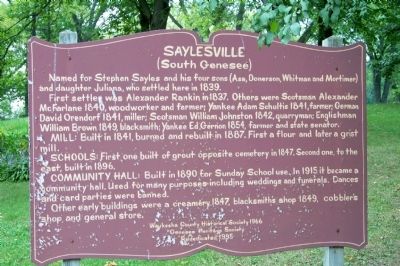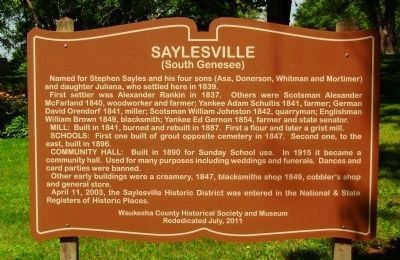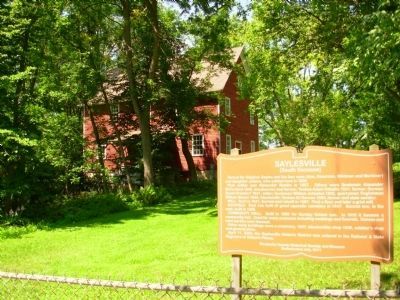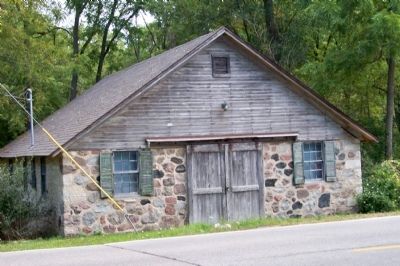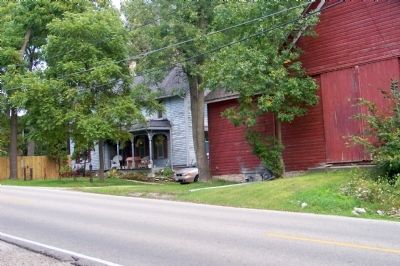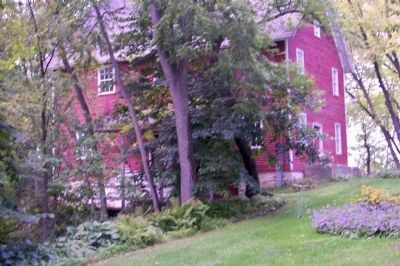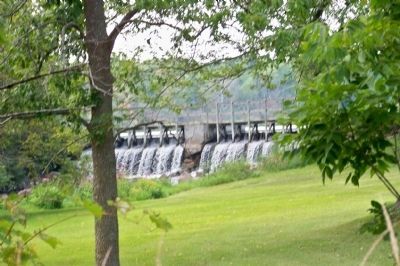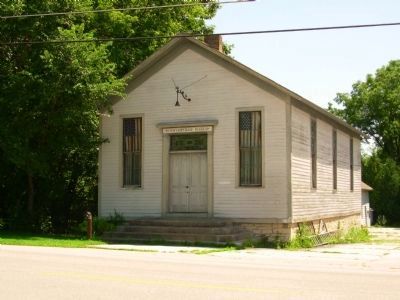Genesee in Waukesha County, Wisconsin — The American Midwest (Great Lakes)
Saylesville
(South Genesee)
First settler was Alexander Rankin in 1837. Others were Scotsman Alexander McFarlane 1840, woodworker and farmer; Yankee Adam Schultis 1841, farmer; German David Orendorf 1841, miller; Scotsman William Johnston 1842, quarryman; Englishman William Brown 1849, blacksmith; Yankee Ed Gernon 1854, farmer and state senator.
Mill: Built in 1841, burned and rebuilt in 1887. First a flour and later a grist mill.
Schools: First one built of grout opposite cemetery in 1847. Second one, to the east, built in 1896.
Community Hall: Built in 1890 for Sunday School use. In 1915 it became a community hall. Used for many purposes including weddings and funerals. Dances and card parties were banned.
Other early buildings were a creamery 1847, blacksmith's shop 1849, cobbler's shop and general store.
Erected 1966 by Waukesha County Historical Society and Genesee Heritage Society. (Marker Number 27-01.)
Topics. This historical marker is listed in this topic list: Settlements & Settlers. A significant historical year for this entry is 1839.
Location. 42° 56.905′ N, 88° 19.346′ W. Marker is in Genesee, Wisconsin, in Waukesha County. Marker is on Saylesville Road (County Route X) 0.1 miles west of Rockwood Trail, on the right when traveling west. Touch for map. Marker is in this post office area: Waukesha WI 53189, United States of America. Touch for directions.
Other nearby markers. At least 8 other markers are within 6 miles of this marker, measured as the crow flies. Genesee Depot (approx. 2.8 miles away); Capel Log (approx. 4˝ miles away); Heaven City (approx. 5 miles away); Lyman Goodnow (approx. 5.4 miles away); Waukesha Engine Division (approx. 5.7 miles away); The Reformed Presbyterian Church of Vernon (approx. 5.7 miles away); Dunbar Oak (approx. 5.8 miles away); Old Cutler Home (approx. 5.9 miles away).
Additional commentary.
1. Saylesville History
The town of Saylesville (South Genesee as it was also known) was settled in 1837 by Alexander Rankin. Saylesville, however, was named for Stephen Sayles and his four sons in 1839. Stephen gave some of his land to be used as a cemetery. His son Whitman damned the creek and with help from David Orndorf and LeSeur they built the mill in 1841. Whitman together with his brother Mortimer built the first creamery. A stone mason by the name of Charles Smith built the stonework for the first mill dam. George Sayles bought out Sewall Andrew's stock in Mukwoanago in 1842 so that he could run his own general
store in Saylesville. When Waukesha County seceded from Milwaukee County, Norman Shultis who was son to pioneer Adam Shultis was one of the first jurymen at the first court held there. He was also elected town chairman and later a member of the legislature.
As he walked the land in Saylesville, William Johnston discovered the quarry stone here and opened his own quarry sometime after 1842. His stone was used in building the State Capitol in Madison, for some of the Carroll College buildings, the Waukesha Methodist Church, and many other buildings in the area. Also a stone bridge was constructed over Spring Lake on Hwy X in 1860. Water from that lake then flowed into the mill pond. William sent for his future wife, Margaret, in Scotland. When she arrived they married in Milwaukee. Their honeymoon was spent walking back to Saylesville and their tiny cabin.
The Blacksmith Shop dates back to the turn of the century and was in use through the 1940s. Today it still stands as it always has. "Brownie", the son of pioneer William Brown, was a blacksmith who used to pound horseshoe nails for the kids "to ward off rheumatism".
The old stone bridge eventually gave way during a flood in 1928. In 1950 a new bridge was constructed. The bridge and dam are still there today.
The old red mill building from 1876 also proudly stands as it did 135 years ago.
— Submitted July 8, 2011, by Linda Hansen of Waukesha, Wisconsin.
2. updated text
The following text has been added to the new marker:
April 11, 2003, the Saylesville Historic District was entered in the National & State Registers of Historic Places.
Waukesha County Historical Society and Museum
Rededicated July, 2011
— Submitted August 11, 2011, by Paul Fehrenbach of Germantown, Wisconsin.
Credits. This page was last revised on June 16, 2016. It was originally submitted on June 15, 2011, by Linda Hansen of Waukesha, Wisconsin. This page has been viewed 1,845 times since then and 209 times this year. Last updated on November 21, 2011, by Paul Fehrenbach of Germantown, Wisconsin. Photos: 1. submitted on June 15, 2011, by Linda Hansen of Waukesha, Wisconsin. 2, 3. submitted on August 11, 2011, by Paul Fehrenbach of Germantown, Wisconsin. 4, 5. submitted on June 15, 2011, by Linda Hansen of Waukesha, Wisconsin. 6, 7. submitted on July 8, 2011, by Linda Hansen of Waukesha, Wisconsin. 8. submitted on August 11, 2011, by Paul Fehrenbach of Germantown, Wisconsin. • Bernard Fisher was the editor who published this page.
